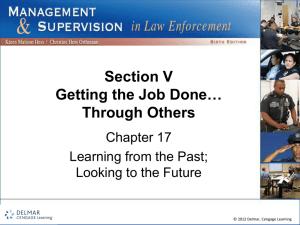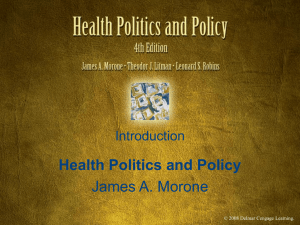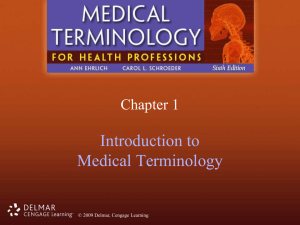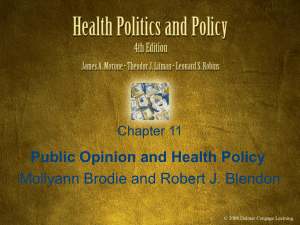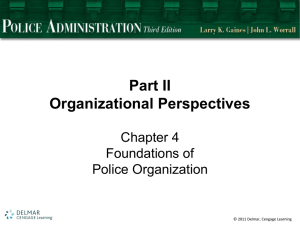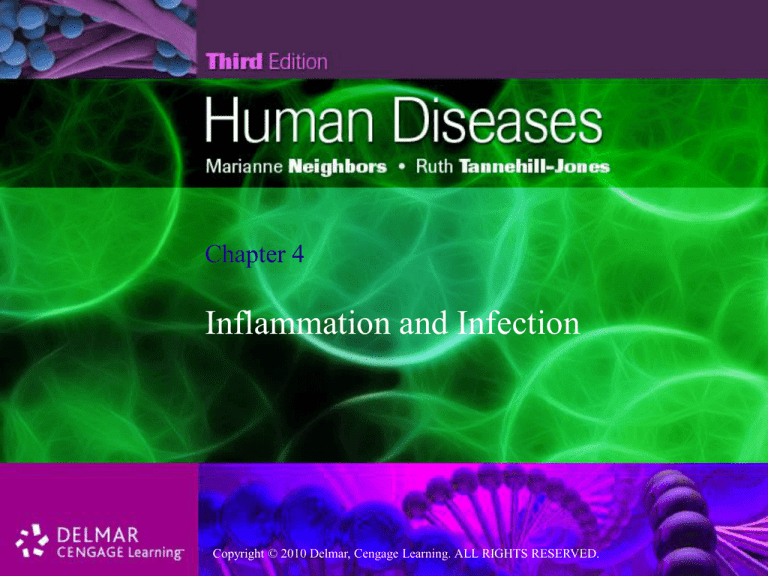
Chapter 4
Inflammation and Infection
Copyright
Copyright
© 2010
© 2010
Delmar,
Delmar,
Cengage
Cengage
Learning.
Learning.
ALLALL
RIGHTS
RIGHTS
RESERVED.
RESERVED.
Defense Mechanisms
• Three lines of defense protect body against
foreign invasion:
– Physical or surface barriers
– Inflammation
– Immune response
Copyright © 2010 Delmar, Cengage Learning. ALL RIGHTS RESERVED.
Inflammation
• Non-specific cellular and vascular reaction to
tissue
• Repels and destroys invader
– Cleans up debris to promote healing
• Requires blood supply
Copyright © 2010 Delmar, Cengage Learning. ALL RIGHTS RESERVED.
Inflammatory Process
• Signs and symptoms:
–
–
–
–
Redness
Heat
Edema
Pain
Copyright © 2010 Delmar, Cengage Learning. ALL RIGHTS RESERVED.
Types of Inflammation
• Acute
– Lasts less than 10 days
• Chronic
– Lasts two weeks or longer
Copyright © 2010 Delmar, Cengage Learning. ALL RIGHTS RESERVED.
Inflammatory Exudates
• Appearance and amount of exudate (blood
fluid) reveals acute or chronic condition
• Serous exudate
– Clear, serum-like fluid
– Acute state of inflammation
– E.g., skin blisters, cold sores
Copyright © 2010 Delmar, Cengage Learning. ALL RIGHTS RESERVED.
Inflammatory Exudates
• Fibrinous exudate
– Indicates larger injury with severe inflammation
– Also known as scab
– E.g., strep throat, bacterial pneumonia forming mesh-like
lesion
Copyright © 2010 Delmar, Cengage Learning. ALL RIGHTS RESERVED.
Inflammatory Exudates
• Purulent exudate
– Pus
• Abscess
– Collection of pus
• Empyema
– Accumulation of pus in body cavity
Copyright © 2010 Delmar, Cengage Learning. ALL RIGHTS RESERVED.
Inflammatory Lesions
• Due to physical or pathologic injury
• Inflammatory lesions include:
– Abscesses
– Ulcers
– Cellulitis
Copyright © 2010 Delmar, Cengage Learning. ALL RIGHTS RESERVED.
Tissue Repair and Healing
• Ongoing process
• Tissue repair:
– Regeneration
• Leads to normal function
– Fibrous connective tissue repair
• Does not lead to normal function
– Scar formation
Copyright © 2010 Delmar, Cengage Learning. ALL RIGHTS RESERVED.
Tissue Healing
• Primary union (first intention)
– Involves approximating edges of wound
– Steps of primary healing:
• Forms scab
• After one to two days, new capillaries begin to bridge gap between
wound edges
Copyright © 2010 Delmar, Cengage Learning. ALL RIGHTS RESERVED.
Tissue Healing
• Primary union (first intention)
– Steps of primary healing:
• Fibroblast grows across deeper wound layers
– Forming granulation tissue
• Scar forms
• E.g., surgical incision
Copyright © 2010 Delmar, Cengage Learning. ALL RIGHTS RESERVED.
Tissue Healing
• Secondary union (secondary intention)
– Involves larger, deeper wounds with more inflammation
than primary union
– Needs more capillaries, fibroblasts, and collagen
Copyright © 2010 Delmar, Cengage Learning. ALL RIGHTS RESERVED.
Tissue Healing
• Secondary union (secondary intention)
– Steps of secondary healing:
• After one week, new soft red tissue produced
– Granulation tissue
• Scar tissue formed
• Healing time dependent on size of wound
Copyright © 2010 Delmar, Cengage Learning. ALL RIGHTS RESERVED.
Animation
Click Here to Play Tissue Repair Animation
Copyright © 2010 Delmar, Cengage Learning. ALL RIGHTS RESERVED.
Delayed Wound Healing
• Debridement
– May be necessary to wash or cut away necrotic tissue and
foreign material
• Factors affecting healing time:
– Age
– Size of wound
Copyright © 2010 Delmar, Cengage Learning. ALL RIGHTS RESERVED.
Delayed Wound Healing
• Factors affecting healing time:
–
–
–
–
–
Location
Nutrition
Circulation
Organism virulence
Steroids
Copyright © 2010 Delmar, Cengage Learning. ALL RIGHTS RESERVED.
Complications of Wound Healing
• Poor or excessive scar formation
• Dehiscence
– Separation of tissue margins
Copyright © 2010 Delmar, Cengage Learning. ALL RIGHTS RESERVED.
Complications of Wound Healing
• Keloid
– Hard, raised scar
• Adhesions
– Fibrous bands of tissue that attach to surfaces of adjacent
organs as scar tissue develops
Copyright © 2010 Delmar, Cengage Learning. ALL RIGHTS RESERVED.
Keloid
Photo courtesy Mark L. Kuss
Copyright © 2010 Delmar, Cengage Learning. ALL RIGHTS RESERVED.
Infection
• Invasion of microorganisms causing cell or
tissue injury
• Pathogenic
– Microorganisms causing disease
• Opportunistic
– Normal flora become pathogenic under certain conditions
Copyright © 2010 Delmar, Cengage Learning. ALL RIGHTS RESERVED.
Infection
• Conditions for flora to become pathogenic:
–
–
–
–
Microorganisms gain access to body through portal of entry
Pathogen resistant to defenses of host
High number of invading microorganisms
Vulnerable condition of individual or host
Copyright © 2010 Delmar, Cengage Learning. ALL RIGHTS RESERVED.
Frequency and Types of Infection
• Infectious diseases
– Leading cause of death worldwide
– Crucial to identify and track
• Centers for Disease Control and Prevention (CDC) provide these
services in United States
Copyright © 2010 Delmar, Cengage Learning. ALL RIGHTS RESERVED.
Frequency and Types of Infection
• Bacteria
– Primary or secondary disease
– Staphylococcus
• Bacterium on skin
– Streptococcus
• Bacterium that live on skin and in throat
Copyright © 2010 Delmar, Cengage Learning. ALL RIGHTS RESERVED.
Frequency and Types of Infection
• Bacteria
– Common enteric bacteria:
• Escherichia coli (E. coli), klebsiella, pseudomonas, shigella, and
salmonella
Copyright © 2010 Delmar, Cengage Learning. ALL RIGHTS RESERVED.
Frequency and Types of Infection
• Viruses
– Smallest infective organism
• Must be visualized by electron microscope
– Cannot reproduce or live outside cell
– Not easily treated
– Not killed by antibiotics
• But antibiotics help prevent secondary infections
Copyright © 2010 Delmar, Cengage Learning. ALL RIGHTS RESERVED.
Frequency and Types of Infection
• Viruses
– Immunizations effective in preventing
• E.g., measles, mumps, rubella, smallpox
– Latent viruses lay dormant in cells and replicate
• Causing symptoms during times of stress
Copyright © 2010 Delmar, Cengage Learning. ALL RIGHTS RESERVED.
Frequency and Types of Infection
• Fungi
– Microscopic plant-like organisms larger than bacteria
– Only few are pathogenic
– Types of infections:
• Tinea
– Skin
• Candida
– Superficial infection of skin and mucous membranes
Copyright © 2010 Delmar, Cengage Learning. ALL RIGHTS RESERVED.
Frequency and Types of Infection
• Fungi
– Treated with antibiotics and antifungal medications
– Often difficult to cure
– May require long-term therapy
Copyright © 2010 Delmar, Cengage Learning. ALL RIGHTS RESERVED.
Frequency and Types of Infection
• Rickettsiae
– Microscopic organisms that are intermediate between
bacteria and viruses
– Must live in host cell
• Like virus
– Spread by fleas, ticks, mites, and lice
– Rocky Mountain spotted fever
• Most common
Copyright © 2010 Delmar, Cengage Learning. ALL RIGHTS RESERVED.
Frequency and Types of Infection
• Protozoa
– Single-celled microscopic organisms
– Found in soil
• Live on dead or decaying material
– Infection through bite of infected insect or ingestion of
spores
– Malaria
• Most common
Copyright © 2010 Delmar, Cengage Learning. ALL RIGHTS RESERVED.
Frequency and Types of Infection
• Helminths
– Roundworms or flatworms
– Pinworms and tapeworms
• Most common
• Pinworms cause anal itching
• Tapeworms cause intestinal disease due to inadequately cooked
meat
Copyright © 2010 Delmar, Cengage Learning. ALL RIGHTS RESERVED.
Testing for Infection
• Blood
• Culture and sensitivity
• Skin
Copyright © 2010 Delmar, Cengage Learning. ALL RIGHTS RESERVED.

